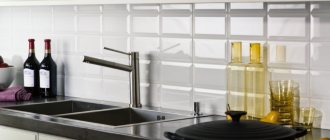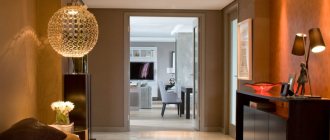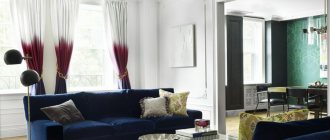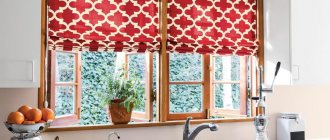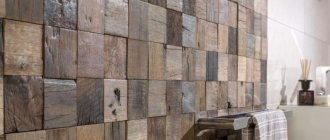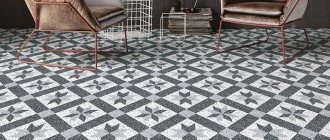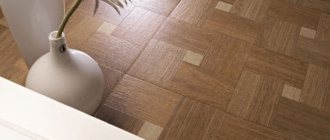Floor tiles in the hallway
In the hallway, the floor is regularly subjected to frequent washing, the action of reagents carried on shoes, and some shoe models can cause damage to the soft surface. Therefore, floor tiles in the hallway are the most practical and at the same time aesthetic covering option.
Note! Our partners, Stroytekhmontazh LLC, always have laminated plywood in Moscow - the lowest prices and the highest quality!
Many people think about flooring in the hallway, and if linoleum is increasingly less of a choice, then laminate competes with tiles. From a practical point of view, no laminate can compare in terms of stability with ceramic tiles.
How to choose tiles for the living room floor, characteristics of the material, features of selection and installation
Floor tiles are a good covering solution for the living room.
It has excellent aesthetic properties and is easy to use. When used in the living room, the building material has important advantages - attractive appearance, ease of maintenance, originality of colors. Decorative tiles complement the interior well, giving the room a unique unique look, making the design more luxurious and presentable. When choosing a covering for the living room, you need to pay special attention to its quality and shades in order to support the overall style and composition of the design.
Living room floor tiles
Features and Benefits
Floor finishing should be designed in advance. If you do not do this, the repair may not improve, but may even worsen the interior. Tiles must be used carefully, taking into account the fact that they must be combined with the interior and furniture.
Practical design in the hallway
Tiles in the hallway interior create the feeling of an “expensive” renovation, while the service life of such a coating is several times longer than options with other materials. For many years, the tile floor in the hallway looks “like new.”
Despite the “coldness” of the material, the floor can add notes of warmth and comfort to the overall interior, or, on the contrary, emphasize official severity. The design of the tile floor in the hallway can be viewed in the catalog of completed works.
In a living space, as a rule, they try to make hallways cozy. If the area is large, then a plain floor will look “official”. The combination of textures and colors allows you to create visual comfort, and additional “warm floor” equipment will make the corridor really warm.
- Using color variations, you can zone the hallway space. You can separate part of the area from another in various ways. For example, use different, contrasting colors of tiles, separate one area from another with a special floor border.
- The soft, bed tones of the tiles will create a feeling of warmth. Beige, coffee, milky shades of warm colors that can be used for the floor in the hallway. A long corridor will be visually expanded by laying out a pattern in the right colors.
- For example, you can take marbled tiles in coffee tones as a basis, and lay out squares of light-colored tiles (milky) in the middle. Various patterns on the surface of ceramic tiles in the hallway allow you to create the most harmonious floor for any design idea.
If the overall interior requires monotony or for other reasons the combined tiles do not fit into the hallway, you can cover the floor with ceramic imitation wood. Today there is a wide range of different sizes and colors of wood-look tiles. “Black” wood or its opposite—white tiles with a wood-like texture—look quite impressive.
Tiles for the living room - 105 photos of ideal combinations and design options
For a long time, most designers believed that floor tiles could be used in interiors only in two cases: if it was a bathroom or if it was a dining room or kitchen.
With the development of technology, almost all modern manufacturers are ready to offer customers original collections of their finishing materials, proving that tiles are suitable not only for the two above-mentioned rooms.
You can easily verify this by looking at fashion blogs dedicated to interior design. It is worth keeping in mind that tile is one of the most practical materials.
If we dwell on the issue of tiles that can be used in the living room, they are divided into several types: decorative, wall, classic floor. They differ in various characteristics.
Pros and cons of using tiles in the living room
Designers who claim that modern tiles can be used for the floor in the living room primarily talk about the various advantages of this material. It is easy to care for, has a long service life, and has a modern character.
It is difficult not to notice the obvious negative characteristics of the tile, which consist in the fact that the material is cold not only stylistically, but also, first of all, for the feet.
However, is this a significant drawback in practice? Today, most owners of apartments and houses are accustomed to choosing a warm, namely heated electric floor as one of the heating methods, which means the second disadvantage of tiles can be canceled.
Speaking about the first drawback, it is worth emphasizing that modern manufacturers, like designers, are ready to offer a wide range of living room interiors with a wide variety of textures, colors and interesting imitations. For this reason, now choosing a tile option that would fit perfectly into the interior is clearly not difficult.
Those who prefer warm, high-quality materials can opt for the popular ceramic tiles imitating wood - one of the most comfortable materials.
Advantages of using ceramic floors
Firstly, tiles in the living room interior are the easiest material to maintain today. All you need to do is simply wash it when cleaning using absolutely any cleaning agent.
This point is especially important if a child lives in the house, because the need to maintain hygiene increases. This is no less convenient when there are cats and dogs in the house, since it becomes much easier to deal with hair.
Secondly, tiles are not capable of absorbing or accumulating dust, unlike carpet and similar coverings. If someone in the house suffers from allergies, a living room design with tiles will be a great salvation.
Thirdly, the floors in the living room made of tiles, in addition to being beautiful, are also quite durable. If we talk about the average lifespan of laminate flooring, in practice it is no more than five years. The manufacturers themselves say that it will require replacement. The tile will definitely last much longer, and the duration itself will depend directly on the quality of the chosen material.
What is important to consider when designing the interior of a living room?
The only fairly important disadvantage of tiles as a covering for a future floor is that they are cold, as mentioned earlier, but this can easily be beat with a warm floor, so it is more important to think about what the layout of the free space in the room will be.
The rule that comes into play is that when using large-sized components in a room with a small area, it will visually appear even smaller.
Therefore, when planning to decorate a small room, it is best to choose small tiles. If the room is spacious enough, it is quite possible to use fairly large parts.
Before the final finishing begins, the floor and walls must be prepared for this type of selected coating. Any beautiful living room tile requires all surfaces in the room to be as level as possible. This will definitely entail additional costs, but the result will please you with durability and reliability.
Particular attention should be paid to combined rooms. This is due to the fact that many designers are accustomed to combining different floor coverings. It is important to take into account the fact that some unheated rooms need frost-resistant tiles.
Important points
It is impossible to ignore such useful tips as floor tiles for the living room should be used so that the room becomes a real place of relaxation that will be pleasing to the eye.
Forget about slippers, the discomfort that guests experienced in the cold field. Use tiles to create warm floors and thus achieve the most comfortable environment for guests.
To decorate the interior of a country house, it is better to use fresh flowers. Tiles can also help with this if you make original flower beds out of them. The landscape design will look luxurious.
If there are small borders or even a staircase in the living room, it is imperative to complement them with designer, decorative tiles. It is quite expensive, but if you want to add real chic to the design of your apartment or house, then this is an ideal option.
If you look at the photo of tiles for the living room, it is easy to notice that designers offer a huge number of different variations of using floor tiles not only for modern interiors, but also for any classic interior.
It is interesting to use this coating when the living room is combined during renovation with a small kitchen or dining room.
The advantages are immediately evident, because not only will there be no need to make any transitions between the main room and the kitchen, but thanks to a single covering, even a small room will look visually larger.
One of the most popular options for the living room is a floor made of porcelain stoneware. When choosing tiles as a flooring material for a room, you don't have to worry about the space being too pretentious or formal.
Thanks to the huge number of different colors of tiles and their shapes, you can create a luxurious and cozy home living room that you will want to return to again and again.
Photo of tiles for the living room
Did you like the article? Share
Source: https://indizajn.ru/plitka-dlya-gostinoj/
Quality of tiles in the hallway
Tiles must be selected primarily taking into account the expected load. The higher the cross-country ability, the more durable the coating should be, including its top layer - painting the tiles.
The favorite for resistance to various types of influences is porcelain stoneware. This material can withstand moisture and is not subject to color abrasion, since the color is not present on the surface, but throughout the entire structure of such tiles.
Another property that will be a significant advantage of decorative tiles in the hallway is a high level of anti-slip properties. This indicator for the hallway should be close to R10-R11
The texture of the tiles is not only decorative. If the textured surface has a lot of roughness, then such elements will contribute to the accumulation of dirt in them. Therefore, closer to the front door, it is better to choose tiles with a smooth surface, but take into account the level of anti-slip.
One of the most practical options is dark porcelain tiles, on which dirt will not be too noticeable. If the interior includes a light floor, you can use a combination of tiles in the hallway and make the area of greatest traffic dark, and the rest of the area is finished with material in lighter colors.
The color of the grout should also be selected from a practical point of view. Light-colored grout will also get dirty and be more difficult to clean even with the help of special chemicals.
Tile design
The varied shapes, textures and shades of ceramic coatings allow the apartment owner to decorate the living room in any way.
To expand the space of the room and give it airiness, the walls are decorated with mirror tiles. The wood-effect covering will add a touch of naturalness and comfort to the decor. You can also combine tiles with laminate by cutting out a curly line and covering it with an elastic threshold. “Marbled” products look great in the interior of the hall. To imitate carpeting, patterns with ornaments are used.
The photo shows an airy living room with sky-colored details. Mirror tiles emphasize the lightness of the decor and visually add space.
Connoisseurs of country style will love the cladding option in the form of panels made of combined tiles of different colors. This technique is called patchwork.
The shape of tiles today is the most diverse - designers offer not only squares and rectangles, but also rhombuses, honeycomb-shaped polyhedrons, and shaped products with rounded elements.
Using stone-like tiles, you can decorate the walls of the living room (either completely or partially), border windows, columns and doorways. Mosaic is suitable for facing fireplaces, as well as decorating walls: it is recommended to place it in inserts so as not to overload the space.
Laying tiles in the hallway
The technology of laying tiles on the floor first of all requires certain installation products. For floor tiles, a special adhesive is used, which contains polymer additives, and the base is a sand-cement mixture.
The consumption of such glue is about 7 kilograms per 1m2. One bag weighing 25 kilograms is enough to lay 3.5 m2, provided the layer thickness is 1 cm. The surface is pre-prepared for better adhesion. To do this, the surface is impregnated with a special composition at the rate of 0.3 liters per 1m2.
- Hallway decor - beautiful ideas and ways to decorate a hallway with your own hands (85 photos and videos)
- Mirror in the hallway - modern design ideas using mirrors (110 photos)
- Hallway in a classic style - interesting options and ready-made solutions for decorating a classic hallway (90 photo ideas)
Tiles can be laid in two ways: traditional and diagonal. With any installation method, the uniformity of the gap between the seams is adjusted using special crosses. The number of these crosses depends on the size of the tiles being laid (on the number of elements in 1m2).
What is porcelain tile?
Porcelain stoneware is a name given to a certain type of artificial stone, which is made from raw materials such as quartz sand, clay, kaolin, feldspars, pegmatites, and water. The material is produced by pressing and high-degree firing. Porcelain stoneware products are used primarily as floor tiles both indoors and outdoors.
Thanks to modern technologies, it is easy for manufacturers to give artificial stone any texture. The material can perfectly imitate natural stone or wood. Today's buyer is offered many shades and color palettes that are easy to choose for a specific stylistic design.
An artificial stone floor is a practical and reliable option for a corridor in a house or apartment. Porcelain tiles in the hallway will look impressive and noble. You can complement any interior with it, regardless of its focus.
Installation of floor tiles
The surface is cleaned of debris and impregnated with a primer. It is convenient to use a roller with fabric when impregnating. In open space, installation usually begins from the middle. The installation is marked with chalk and the process begins based on it.
The diluted mixture for laying tiles should sit for 10-15 minutes. The adhesive is applied to the floor with a notched trowel and the tiles are pressed against the mortar. For tight shrinkage. The surface of the tile is tapped with a rubber mallet. The horizontalness of each element is checked by a level.
You can adjust the position of the tiles on the glue within 15 minutes, after which the glue will begin to set. After laying the next element, a cross is installed in the gap. After laying all the tiles, the seams are grouted.
Walls in the hallway - finishing options and tips for decorating walls in the hallway. Original ideas and stylish combinations (105 photos)- Console in the hallway - original ideas for using consoles in modern hallways (125 photos)
- Bedside table in the hallway - the best options for using bedside tables in modern interiors (140 photos and videos)
Grouting is done with a rubber spatula. It is important not to confuse the grout for walls and floors. The quality of installation depends on compliance with the technology of the entire process, starting from preparing the surface and ending with leveling the entire floor.
How to care for porcelain stoneware floors?
If you have chosen porcelain tiles for the floors in the hallway, be sure to find out the specifics of caring for them. As a rule, any tile is practical, it is easy to clean, and it is easy to remove dirt, dust and other contaminants from it. For washing, you can use plain water, with the addition of detergent if desired. The flooring is resistant to chemical attack, so it is not afraid of alkalis and acids.
Please also note that it is better to leave the installation of porcelain tiles to professionals. Only proper floor finishing in compliance with all standards will extend the life of the finishing material. After professional installation, the tiles look more beautiful, neat, and impressive, especially if we are talking about models with a pattern or design, where a certain sequence must be followed.
Is it worth choosing porcelain tiles for the hallway? Of course it’s worth it if you want a floor in your home that will serve you for many years. A variety of shades and textures will allow you to choose exactly the option that will not only decorate the corridor, but also the object of your pride in front of your guests.
Photo of floor tile layout for the hallway
Ottoman in the hallway - application in design and main options for assigning the best models (110 photos)Design of a hallway in an apartment - tips for arranging a timely hallway and ideas for choosing interior elements (90 photos)
Forged hallways - stylish and fashionable design ideas for decorating with forged interior elements (115 photos)
Look here: Bright hallway - 130 photos of examples of modern style and beautiful bedroom design in light colors
Did you like the article?
0
4
Narrow
Narrow tiles are a trend that broke out on the pages of interior publications last year. Promises to linger in bathrooms and kitchens. Small narrow tiles can become an interesting analogue of a classic mosaic; they also do not require trimming or joining.
Your own atmosphere: where to buy photo wallpapers and how to use them
Where to buy photo wallpaper: stores and prices of TC "Lanskoy"
A larger option will be an alternative to the boring “hog”. Both horizontal and vertical installation looks interesting. The current solution is a chevron tiled floor.
Ceramic tile trends 2020
The ceramics industry must take into account changing stylistic trends, while keeping in mind that the consumer wants a product that they will not tire of after a few months. To do this, architects and designers observe the industry, take part in international exhibitions, and look for inspiration in various fields.
Here are a few trends that deserve consumer attention:
- stone inspiration;
- natural motives;
- textured design;
- large format;
- geometric patterns;
- minimalism;
- surfaces imitating metal and fabric;
- imitation concrete;
- mirror surfaces;
- patchwork.
Let's take a closer look at them.
Stone inspiration
Stone almost always inspires designers. It attracts, first of all, with its solidity and restraint - both in terms of color and design. Fashionable ceramic tiles for the bathroom 2018, imitating the texture and pattern of natural stone, also look good in the company of colorful decorations. Thanks to add-ons, you can quickly update your composition at minimal cost. It is enough to replace the curtains, tablecloths, towels in the bathroom and the interior takes on a completely new character.
Natural motives
Not long ago, nature motifs fascinated lovers of good design. This year's offerings are not significantly different from current trends. In addition, this trend will intensify next year. In addition to plants, wildlife is also invited into the interiors.
Neutral and calm colors such as beige, brown and gray are still at the top of their popularity. The trend towards nature is clearly visible in the large number of tiles imitating wood and natural stones.
This is an offer for people who lead an ecological and harmonious lifestyle. Motifs taken from nature should be used as a backdrop for seasonal decorations: flowers, textiles, colorful bird figures or posters with mysterious forest animals.
Interesting solutions can be made from mosaics, with the help of which an image is reproduced on the wall. The plot can be unique, made to order according to the client’s sketch.
Textured design
The design of tiles with an unusual texture is a trend that will be offered by manufacturers for a long time. Technological developments have made it possible in recent years to create patterns in three dimensions. Any bulges or indentations will create a new chapter in the history of design. The fashion for textured tiles will probably not disappear. This trend will continue and develop in the coming years.
Next year you should pay attention to ceramics with a texture reminiscent of:
- textile;
- a natural stone;
- tree;
- with modern geometric patterns.
Geometric patterns
Manufacturers will also pay a lot of attention to three-dimensional surfaces and geometric patterns in the coming year. Triangles, squares, hexagons, fantastic flowers have recently dominated the most fashionable arrangements. Geometric mélange enthusiasts also include bathrooms.
Hexagons are an absolute geometric necessity! Honeycomb tiles are ideal for bathroom interiors - they add style and break the “square” cliché. Hexagonal variations can come in different sizes, colors and patterns. Therefore, you can choose small mosaics or large formats, rainbow or monochrome options, smooth tiles with honeycombs or decorated with fancy patterns.
The classic rhombus boldly competes with the hexagon for the title of king of geometric combinations. As it turns out, this simple, inconspicuous figure has enormous potential!
If you don’t like non-obvious solutions, and geometric patterns with a flat structure convey too little extravagance, you can choose models with an asymmetrically convex surface. Such compositions create amazing three-dimensional mosaics on the walls, thanks to which rooms become deeper and appear visually larger. The play of light and shadows plays an important role here.
Geometry doesn’t have to be placed only in modern interiors! An interesting alternative is to play with geometric shapes in stylized arrangements.
Large format
The innovative approach of manufacturers allows not only the creation of 3D projects, but also increasingly larger formats of ceramic tiles. Thanks to them, the interior acquires an exclusive and stylish character. When choosing such a unique solution, it is worth presenting it correctly in the interior. It is not advisable to play with colors and excessive decoration of rooms. The large format is the soloist, on whom all attention should be focused. On large surfaces the pattern of stone or natural wood can be most beautifully presented.
Large-scale formats are certainly characteristic of the most fashionable floor tiles of 2020. This is the future hit of popular technology and design trends. The dimensions of the slabs can reach 119 × 239 cm.
Minimalism
Minimalism will never go out of style. The raw design allows you to freely shape the character of the interior through decorations and colors, while maintaining order and mature elegance. This style appeals to people who want to express themselves and at the same time create a versatile space in which everyone feels good.
In 2020, minimalist tiles will be combined with a cozy atmosphere and natural accents. The interior will feature natural, untreated wood, fabrics with a pronounced structure and floral elements.
Surfaces imitating metal and fabric
An interesting trend is metal surfaces - in the form of shiny details on tiles or entire collections that imitate the texture of old metal.
A cozy atmosphere will be created in the bathroom or kitchen by tiles that imitate the texture of fabric.
Concrete imitating tiles
It is difficult to organize industrial, atmospheric lofts without introducing a certain amount of raw, rough finishing materials into them. This function can be completely performed by tiles that imitate concrete. This offer is for people who want to create stylish and modern arrangements without having to deal with the hassles associated with using composite materials. There are many reasons to implement ideas with simulated concrete.
Fans of eco-style solutions can successfully use concrete-like slabs in the living room. Ecological flooring made from tiles imitating concrete is an offer for people who value nature and simplicity. The material will highlight the beauty of accessories and design elements, referring to ecological style and the natural world. It will work great in combination with wood and green plants.
In the kitchen, the concrete floor surface will be non-slip; such materials are slip-resistant, effectively providing comfortable conditions for using the room. The floor will fit perfectly into modern, contemporary arrangements and will emphasize the charm of industrial solutions in the interior.
Fashionable bathroom tiles 2020 that imitate concrete will look good. If you plan to decorate your bathroom in a modern way and decorate it with elements inspired by geometric shapes, then an imitation concrete floor would be a good solution. It will successfully decorate not only characteristic and modernist stylizations, but also classic and eclectic ones.
Mirror tiles
Interesting new ceramic tiles for 2020 are mirror models. In the coming year, such a surface will gain popularity. It is suitable for the kitchen, bathroom, hallway and even for decorating some areas of the walls of the living room or bedroom. Mirror ceramics will be a godsend for fans of glamorous interiors. Such a surface will reflect light, thereby visually increasing the space. This is an excellent choice for small rooms. The range is quite large and includes many models of different colors and formats.
Collections can be complemented by glass mosaics with interesting structures and avant-garde colors that sparkle in thousands of colors. Their characteristic features are also uneven edges and irregular surfaces of the elements. Mosaic tiles fit perfectly into minimalist and modern interiors. By combining them with simple slabs, we bring rooms to life, highlighting their original and timeless design.
The reason for using glass tiles in the kitchen is that they are easy to clean. It is resistant to grease and limescale deposits from drying water. For daily care and maintenance, standard glass and cloth cleaning products are sufficient.
Patchwork
Collections of tiles laid using the patchwork or patchwork technique are still popular. Who today remembers that this style was created as a result of a lack of money to buy and install tiles? Currently, few people associate this styling technique with the history of its origin. Many manufacturers offer collections with patchwork patterns in one form or another.
In some collections, the tiles have the same format, but different patterns.
There are collections where only the decor is made using the patchwork technique.
Others offer mosaics with different patterns on individual cubes, or entire tiles whose surfaces are decorated with a pattern that gives the appearance of several smaller tiles placed next to each other in a patchwork mosaic.
At the same time, fewer patchwork tiles have been seen at exhibitions compared to how popular they have been in recent years.

